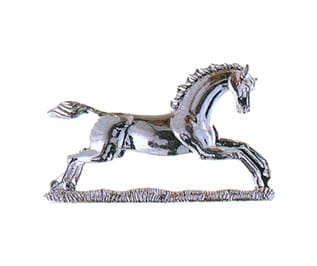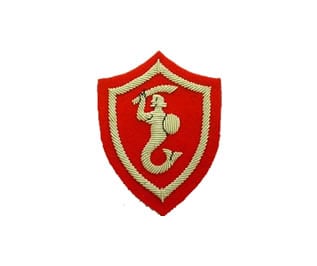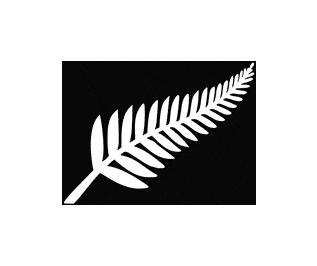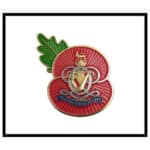Badges and Privileges of the Regiment
The Crest

The Crest is borne in the centre of the Guidon and on the Regimental flag.
It consists of a White Horse of Hanover bestowed on the 3rd Hussars by King George I in 1715, below the Angel Harp, bestowed on the 8th Hussars, because of links with Ireland.
The whole is encircled by the garter of the Order of the Garter given to both the 3rd and 7th Hussars and surmounted by the St Edward’s Crown.
The Cap Badge

The cap badge is made up of the Angel Harp of the 8th Hussars and the Queen’s Royal Irish Hussars on the Regimental cypher of the Queen’s Own Hussars, bestowed on the 7th Hussars in 1727.
The whole is surmounted by a crown and a lion, with a scroll underneath giving the Regiment’s title in blue and gold.
The Collar Badge

The collar badge consists of the White Horse of Hanover galloping.
It is an exact copy of the last collar badge of the 3rd The King’s Own Hussars.
Apart from the Crown, it ranks second among our military badges.
It was bestowed by the first three King Georges to certain regiments for their part in suppressing the Jacobites.
The Maid of Warsaw

Worn on the left sleeve of Service Dress and No2 Dress, awarded to the 7th Hussars by the Commander of the 2nd Polish Corps in recognition of their valour in support of the Polish Forces during the Italian Campaign in the Second World War.
The Fern Leaf

Worn on the left arm in combat uniform by Other Ranks in a tank commander’s appointment at Regimental Duty and displayed on all Regimental vehicles.
The emblem of New Zealand is worn in commemoration of the association of The 3rd Hussars with the 2nd New Zealand Division at the battle of El Alamein.
The Regimental Colours
The primary colour of the Regiment is Garter Blue, the colour of the sash of The Order of the Garter. This colour was first used by the Queen Consort’s Regiment of Dragoons, later the 3rd Hussars, who in 1685 wore the Queen’s Livery with Garter Blue feathered hats and it has been in continuous use since then.
The colour green, although traditionally associated with Ireland, was the facing colour of the 4th Hussars as early as 1748.
Yellow is the traditional Light Cavalry colour and at some stage was used by all the previous Regiments.
Cornets and Sergeant Majors
The Regiment continues the cavalry traditions of referring to their most junior officers as Cornets rather than 2nd Lieutenants, and N.C.O.s holding the rank of Staff Sergeant are addressed as Sergeant Major.
Lance Corporals and Corporals
In several cavalry regiments including the Queen’s Royal Hussars, N.C.O.s holding the rank of Lance Corporal wear two chevrons rather than one (allegedly Queen Victoria did not like the look of only one chevron during a review).
Corporals are distinguished by the addition of a cypher above their two chevrons in dress uniforms.
Regimental Days
The following are celebrated as the Regiment’s Battle Honour Days:
| Dettingen | 27 June | 3H, 4H and 7H |
| Balaklava | 25 October | 4H and 8H |
| Alamein | 2 November | 3H, 4H and 8H |
St Patrick’s Day (17 March) is also celebrated by the Regiment.
The Regimental Collect
Almighty God, whose perfect love casteth out fear, remember in Thy great goodness The Queen’s Royal Hussars and all who serve with us. Keep us mindful of former valour, and grant us, Thy Grace, that whatsoever our minds and hands shall find to do for Thee, we may endure hardships as Thy good and faithful soldiers, and so enter into Thy glory, through Jesus Christ our Lord. Amen.
The Loyal Toast
Officers dining in the Regimental Officers’ Mess have the privilege of not drinking the loyal toast and ignoring the National Anthem when it is played at dinner.
This originates from the Jacobite Rebellion in 1745 when all Army officers were required to drink to the health of the Sovereign in their messes after dinner as a token of loyalty.
The King, however, absolved the Regiment (3H) from this, saying their loyalty was always beyond question. This privilege was re-affirmed by the Sovereign prior to amalgamation.
The Scarlet Collar
The Scarlet Collar still worn today by all ranks of The Queen’s Royal Hussars in No1 Dress was inherited from The 3rd Hussars who were unique amongst British Hussars Regiments in this dress distinction despite it being common amongst European Armed Forces.
It has been said that the 3rd adopted the scarlet collar in recognition of the large proportion of the Regiment who died of neck wounds at the battle of Dettingen, however, there is little historical evidence to support this theory.
Prince Phillip’s Squadron
Prince Philip’s Squadron is named in honour of our late Colonel in Chief and is awarded as an annual namesake to the top-performing Squadron that year.
The Tent Hat
It seems certain that the tent hat was originally introduced to the 8th Hussars by Lt Col HF Deare in 1909. At the time the 8th was in India, having had six years in the UK following the South African war.
Initially, the tent hat was worn with mess dress rather than the scarlet forage cap and it was known as the ‘Balaklava headdress’, although the reasons for this are unclear.
However, the following might shed some light on this:
“We might also take the opportunity here to take a general view of the daily scene in the officers’ line of the cavalry camp in the Crimea. Originality in costume when on service has been favoured by our army officers ever since the Peninsular War. In the camp at Devna officers when not actually on parade with troops were soon strolling about in a style of dress which bewildered all. Check sporting coats were worn over striped regimental pants, with fancy shirts and flowered neckerchiefs. Headwear might be a gold-braided forage cap, a felt wideawake, a Turkish fez from the bazaars or a French kepi. Felt wideawakes of all colours might also be seen with an otherwise impeccable regimental rig”. – Source: Tisdall, E.E.P….., Mrs Duberly’s Campaigns, Jarrolds Publishing, 1963.
After the Second World War, there was a drive for uniformity across the RAC but under Air Marshal, Sir John Baldwin’s tenure as Colonel of the 8th Hussars was a little more stubborn. Luckily a change of CIGS meant a change in direction on the dress in the RAC and the idiosyncrasy of the Cavalry Regiments remained.
All Officers of the QRH wear the distinctive green and gold ‘Irish Lace’ tent hat when in Service Dress and when in barracks instead of a beret. The Commanding Officer has an additional line of gold running along the top crease of the tent hat. Any Officer who has commanded the Regiment retains the additional gold line thereafter.


